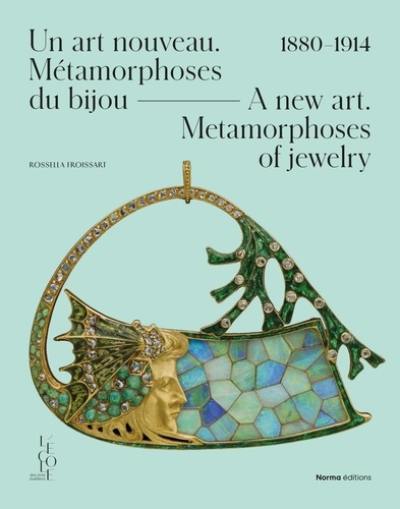
Paru le 16/06/2023 | Relié 208 pages
Tout public
texte Florent Guérif, Paul Hubert Paradis | préface Lise Macdonald, Nicolas Bos | traduction anglaise Alexei Du Périer
Le bijou occupe une place centrale dans l'évolution profonde que connaît l'esthétique à partir des années 1880. Loin d'être le simple reflet d'une histoire de l'art qui s'écrit ailleurs - dans les domaines « majeurs » de la peinture, de la sculpture ou de l'architecture - , il participe au renouvellement radical d'un imaginaire fécondé par l'élargissement des connaissances scientifiques et par leur diffusion dans une culture visuelle amplement partagée.
La réflexion sur la représentation de la vie, des forces qui l'animent et des principes qui en déterminent la construction prend un sens original pour des artistes, des artisans et des fabricants dont le premier ressort de la création est la matière : une matière changeante et malléable qui suggère les flux dynamiques, mais aussi une matière formidablement résistante, somptueuse et fantasmagorique.
Réceptifs aux inspirations historicistes, engagés dans les recherches symbolistes et dans l'Art nouveau, puis sensibles au nouvel ordre décoratif, les grands noms des Falize, Boucheron, Vever ou Fouquet côtoient ceux d'artistes tels que René Lalique, Eugène Grasset, Alphonse Mucha, Henry Nocq, Jules Desbois ou Édouard Monod-Herzen dans une même volonté de placer le bijou au coeur de l'invention des formes.
Accompagné d'un glossaire des matériaux et des techniques et d'une ample bibliographie, cet ouvrage permet de comprendre l'extraordinaire essor de l'art de la bijouterie et de la joaillerie en France entre 1880 et 1914.
Jewelry holds a central place in the profound evolution in aesthetics that began in the 1880s. Far from being a mere reflection of a history of art written elsewhere-in the « major » fields of painting, sculpture, or architecture-it played an active role in a radical imaginative renewal fueled by developments in scientific knowledge that were being diffused across a newly invigorated visual culture.
For the artists, crafters, and manufacturers who worked above all with matter - a matter that was changeable, malleable, and suggestive of dynamic flows, but also incredibly durable, opulent, and phantasmagoric - reflection on the representation of life, on the forces animating it, and on the principles of its form, now took on a new and original meaning. Inspired by historicism, engaged in the Symbolist and Art Nouveau movements, and receptive to the new decorative order, the great names of Falize, Boucheron, Vever, and Fouquet united with those of artists such as René Lalique, Eugène Grasset, Alphonse Mucha, Henry Nocq, Jules Desbois, and Édouard Monod-Herzen in the same desire to locate jewelry at the heart of the creation of new forms.
Supplemented with a glossary of materials and techniques, as well as an ample bibliography, this book helps us understand the extraordinary rise of the art of jewelry and bijouterie in France from 1880 to 1914.